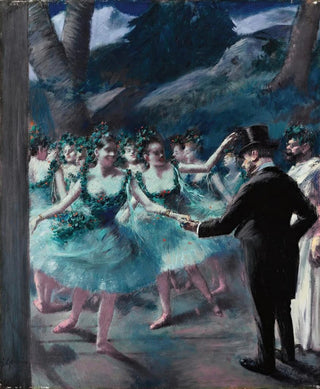Art print | The Ballet - Jean-Louis Forain


View from behind

Frame (optional)
In the fascinating world of art, some works manage to capture the very essence of a moment, an emotion, an atmosphere. "The Ballet" by Jean-Louis Forain is one of those creations that transcends the simple frame of painting to immerse us in the vibrant and effervescent universe of ballet. This piece, with its dynamic depiction of dancers in full performance, evokes not only the beauty of movement but also the magic of living art. Forain's mastery in rendering gestures and expressions makes this work a poignant testament to the passion and grace that characterize the art of ballet.
Style and uniqueness of the work
Jean-Louis Forain's style is both refined and bold. In "The Ballet," he manages to capture the energy and emotion of a theatrical performance with remarkable finesse. The colors, carefully chosen, blend harmoniously to create an atmosphere that is both intimate and explosive. The figures of the dancers, rendered with great precision, seem almost to emerge from the canvas, animated by a vital force that transcends time. Forain excels in the art of composition, where each element is arranged to guide the viewer's gaze across the scene, as if they themselves were a privileged witness to this spectacle. This ability to render movement and emotion makes it an emblematic work of impressionist style, while maintaining a singularity unique to the artist.
The artist and his influence
Jean-Louis Forain, born in Paris in 1852, is an artist who distinguished himself in the artistic landscape of his time. Influenced by the masters of the Impressionist movement, he develops a unique style that allows him to explore various themes, ranging from daily life to theatrical scenes. Forain is also known for his social engagement, using his art as a means to comment on the society of his era. His work "The Ballet" fits into this approach, revealing not only the beauty of dance but also the social and cultural issues surrounding it. As a witness to Parisian life, he immortalizes scenes that continue to inspire and fascinate subsequent generations, thus consolidating

Matte finish

View from behind

Frame (optional)
In the fascinating world of art, some works manage to capture the very essence of a moment, an emotion, an atmosphere. "The Ballet" by Jean-Louis Forain is one of those creations that transcends the simple frame of painting to immerse us in the vibrant and effervescent universe of ballet. This piece, with its dynamic depiction of dancers in full performance, evokes not only the beauty of movement but also the magic of living art. Forain's mastery in rendering gestures and expressions makes this work a poignant testament to the passion and grace that characterize the art of ballet.
Style and uniqueness of the work
Jean-Louis Forain's style is both refined and bold. In "The Ballet," he manages to capture the energy and emotion of a theatrical performance with remarkable finesse. The colors, carefully chosen, blend harmoniously to create an atmosphere that is both intimate and explosive. The figures of the dancers, rendered with great precision, seem almost to emerge from the canvas, animated by a vital force that transcends time. Forain excels in the art of composition, where each element is arranged to guide the viewer's gaze across the scene, as if they themselves were a privileged witness to this spectacle. This ability to render movement and emotion makes it an emblematic work of impressionist style, while maintaining a singularity unique to the artist.
The artist and his influence
Jean-Louis Forain, born in Paris in 1852, is an artist who distinguished himself in the artistic landscape of his time. Influenced by the masters of the Impressionist movement, he develops a unique style that allows him to explore various themes, ranging from daily life to theatrical scenes. Forain is also known for his social engagement, using his art as a means to comment on the society of his era. His work "The Ballet" fits into this approach, revealing not only the beauty of dance but also the social and cultural issues surrounding it. As a witness to Parisian life, he immortalizes scenes that continue to inspire and fascinate subsequent generations, thus consolidating






